Evaluation of the Offsets of Artificial Recharge on the Extra Run-Off Induced by Urbanization and Extreme Storms Based on an Enhanced Semi-Distributed Hydrologic Model with an Infiltration Basin Module
Abstract
1. Introduction
2. Materials and Methods
2.1. Modeling Framework
2.2. Artificial Recharge Infiltration Basin Module
2.3. Climate Change and Urbanization
2.4. Study Area and Model Setup
2.5. Modeling Scenarios
3. Results and Discussion
3.1. Modeling Performance
3.2. Changes in Precipitation, Urbanization, and Discharge
3.3. Impacts of Artificial Recharge via Infiltration Basin
4. Summary and Conclusions
Author Contributions
Funding
Data Availability Statement
Conflicts of Interest
References
- Jasechko, S.; Seybold, H.; Perrone, D.; Fan, Y.; Shamsudduha, M.; Taylor, R.G.; Kirchner, J.W. Rapid groundwater decline and some cases of recovery in aquifers globally. Nature 2024, 625, 715–721. [Google Scholar]
- Hernandez, E.A.; Uddameri, V. Standardized precipitation evaporation index (SPEI)-based drought assessment in semi-arid south Texas. Environ. Earth Sci. 2014, 71, 2491–2501. [Google Scholar] [CrossRef]
- Dillon, P.; Stuyfzand, P.; Grischek, T.; Lluria, M.; Pyne, R.D.; Jain, R.C.; Bear, J.; Schwarz, J.; Wang, W.; Fernandez, E.; et al. Sixty years of global progress in managed aquifer recharge. Hydrogeol. J. 2018, 27, 1–30. [Google Scholar] [CrossRef]
- Robinson, W.A. Climate change and extreme weather: A review focusing on the continental United States. J. Air Waste Manag. Assoc. 2021, 71, 1186–1209. [Google Scholar] [CrossRef]
- Siddik, M.S.; Tulip, S.S.; Rahman, A.; Islam, M.N.; Haghighi, A.T.; Mustafa, S.M.T. The impact of land use and land cover change on groundwater recharge in northwestern Bangladesh. J. Environ. Manag. 2022, 315, 115130. [Google Scholar] [CrossRef]
- Rahman, A.; Mojid, M.A.; Banu, S. Climate change impact assessment on three major crops in the north-central region of Bangladesh using DSSAT. Int. J. Agric. Biol. Eng. 2018, 11, 135–143. [Google Scholar] [CrossRef]
- Qi, T.; Shu, L.; Li, H.; Wang, X.; Men, Y.; Opoku, P.A. Water distribution from artificial recharge via infiltration basin under constant head conditions. Water 2021, 13, 1052. [Google Scholar] [CrossRef]
- Wu, P.; Comte, J.C.; Li, F.; Chen, H. Influence of tides on the effectiveness of artificial freshwater injection in mitigating seawater intrusion in an unconfined coastal aquifer. J. Hydrol. 2023, 617, 129043. [Google Scholar] [CrossRef]
- Wu, P.; Shu, L.; Comte, J.C.; Zuo, Q.; Wang, M.; Li, F.; Chen, H. The effect of typical geological heterogeneities on the performance of managed aquifer recharge: Physical experiments and numerical simulations. Hydrogeol. J. 2021, 29, 2107–2125. [Google Scholar] [CrossRef]
- Stefan, C.; Ansems, N. Web-based global inventory of managed aquifer recharge applications. Sustain. Water Resour. Manag. 2018, 4, 153–162. [Google Scholar] [CrossRef]
- Ringleb, J.; Sallwey, J.; Stefan, C. Assessment of Managed Aquifer Recharge through Modeling—A Review. Water 2016, 8, 579. [Google Scholar] [CrossRef]
- Khan, S.; Mushtaq, S.; Hanjra, M.A.; Schaeffer, J. Estimating potential costs and gains from an aquifer storage and recovery program in Australia. Agric. Water Manag. 2008, 95, 477–488. [Google Scholar] [CrossRef]
- Steinel, A.; Schelkes, K.; Subah, A.; Himmelsbach, T. Spatial multi-criteria analysis for selecting potential sites for aquifer recharge via harvesting and infiltration of surface runoff in north Jordan. Hydrogeol. J. 2016, 24, 1753–1774. [Google Scholar] [CrossRef]
- Beganskas, S.; Fisher, A.T. Coupling distributed stormwater collection and managed aquifer recharge: Field application and implications. J. Environ. Manag. 2017, 200, 366–379. [Google Scholar] [CrossRef]
- Fatkhutdinov, A.; Stefan, C. Multi-Objective Optimization of Managed Aquifer Recharge. Groundwater 2018, 57, 238–244. [Google Scholar] [CrossRef]
- Franczyk, J.; Chang, H. The effects of climate change and urbanization on the runoff of the Rock Creek basin in the Portland metropolitan area, Oregon, USA. Hydrol. Process. Int. J. 2009, 23, 805–815. [Google Scholar] [CrossRef]
- Pan, S.; Liu, D.; Wang, Z.; Zhao, Q.; Zou, H.; Hou, Y.; Liu, P.; Xiong, L. Runoff responses to climate and land use/cover changes under future scenarios. Water 2017, 9, 475. [Google Scholar] [CrossRef]
- Han, Q.; Xue, L.; Qi, T.; Liu, Y.; Yang, M.; Chu, X.; Liu, S. Assessing the Impacts of Future Climate and Land-Use Changes on Streamflow under Multiple Scenarios: A Case Study of the Upper Reaches of the Tarim River in Northwest China. Water 2023, 16, 100. [Google Scholar] [CrossRef]
- Ebrahimian, A.; Gulliver, J.S.; Wilson, B.N. Effective impervious area for runoff in urban watersheds. Hydrol. Process. 2016, 30, 3717–3729. [Google Scholar] [CrossRef]
- Bucton, B.G.B.; Shrestha, S.; Saurav, K.C.; Mohanasundaram, S.; Virdis, S.G.; Chaowiwat, W. Impacts of climate and land use change on groundwater recharge under shared socioeconomic pathways: A case of Siem Reap, Cambodia. Environ. Res. 2022, 211, 113070. [Google Scholar] [CrossRef] [PubMed]
- Wang, R.; Kalin, L. Combined and synergistic effects of climate change and urbanization on water quality in the Wolf Bay watershed, southern Alabama. J. Environ. Sci. 2018, 64, 107–121. [Google Scholar] [CrossRef] [PubMed]
- Mahdian, M.; Hosseinzadeh, M.; Siadatmousavi, S.M.; Chalipa, Z.; Delavar, M.; Guo, M.; Abolfathi, S.; Noori, R. Modelling impacts of climate change and anthropogenic activities on inflows and sediment loads of wetlands: Case study of the Anzali wetland. Sci. Rep. 2023, 13, 5399. [Google Scholar] [CrossRef] [PubMed]
- Gassman, P.W.; Sadeghi, A.M.; Srinivasan, R. Applications of the SWAT model special section: Overview and insights. J. Environ. Qual. 2014, 43, 1–8. [Google Scholar] [CrossRef] [PubMed]
- Jeong, J.; Kannan, N.; Arnold, J.; Glick, R.; Gosselink, L.; Srinivasan, R. Development and integration of sub-hourly rainfall–runoff modeling capability within a watershed model. Water Resour. Manag. 2010, 24, 4505–4527. [Google Scholar] [CrossRef]
- Arnold, J.G.; Moriasi, D.N.; Gassman, P.W.; Abbaspour, K.C.; White, M.J.; Srinivasan, R.; Jha, M.K. SWAT: Model use, calibration, and validation. Trans. ASABE 2012, 55, 1491–1508. [Google Scholar] [CrossRef]
- Neitsch, S.L.; Arnold, J.G.; Kiniry, J.R.; Williams, J.R. Soil and Water Assessment Tool Theoretical Documentation Version 2009; Texas Water Resources Institute: College Station, TX, USA, 2011.
- Teatini, P.; Comerlati, A.; Carvalho, T.; Gütz, A.Z.; Affatato, A.; Baradello, L.; Paiero, G. Artificial recharge of the phreatic aquifer in the upper Friuli plain, Italy, by a large infiltration basin. Environ. Earth Sci. 2015, 73, 2579–2593. [Google Scholar] [CrossRef]
- Schuh, W.M. Seasonal variation of clogging of an artificial recharge basin in a northern climate. J. Hydrol. 1990, 121, 193–215. [Google Scholar] [CrossRef]
- Zou, Z.; Shu, L.; Min, X.; Chifuniro Mabedi, E. Clogging of infiltration basin and its impact on suspended particles transport in unconfined sand aquifer: Insights from a laboratory study. Water 2019, 11, 1083. [Google Scholar] [CrossRef]
- Rouholahnejad, E.; Abbaspour, K.C.; Vejdani, M.; Srinivasan, R.; Schulin, R.; Lehmann, A. A parallelization framework for calibration of hydrological models. Environ. Model. Softw. 2012, 31, 28–36. [Google Scholar] [CrossRef]
- Nash, J.E.; Sutcliffe, J.V. River flow forecasting through conceptual models part I—A discussion of principles. J. Hydrol. 1970, 10, 282–290. [Google Scholar] [CrossRef]
- Moriasi, D.N.; Arnold, J.G.; Van Liew, M.W.; Bingner, R.L.; Harmel, R.D.; Veith, T.L. Model evaluation guidelines for systematic quantification of accuracy in watershed simulations. Trans. ASABE 2007, 50, 885–900. [Google Scholar] [CrossRef]
- Shabani, A.; Zhang, X.; Chu, X.; Dodd, T.P.; Zheng, H. Mitigating Impact of Devils Lake Flooding on the Sheyenne River Sulfate Concentration. J. Am. Water Resour. Assoc. 2020, 56, 297–309. [Google Scholar] [CrossRef]
- Tahmasebi Nasab, M.; Grimm, K.; Bazrkar, M.H.; Zeng, L.; Shabani, A.; Zhang, X.; Chu, X. SWAT modeling of non-point source pollution in depression-dominated basins under varying hydroclimatic conditions. Int. J. Environ. Res. Public Health 2018, 15, 2492. [Google Scholar] [CrossRef] [PubMed]
- Zeng, L.; Shao, J.; Chu, X. Improved hydrologic modeling for depression-dominated areas. J. Hydrol. 2020, 590, 125269. [Google Scholar] [CrossRef]
- Khanaum, M.M.; Borhan, M.S. Effects of Increasing Rainfall Depths and Impervious Areas on the Hydrologic Responses. Open J. Mod. Hydrol. 2023, 13, 114–128. [Google Scholar] [CrossRef]
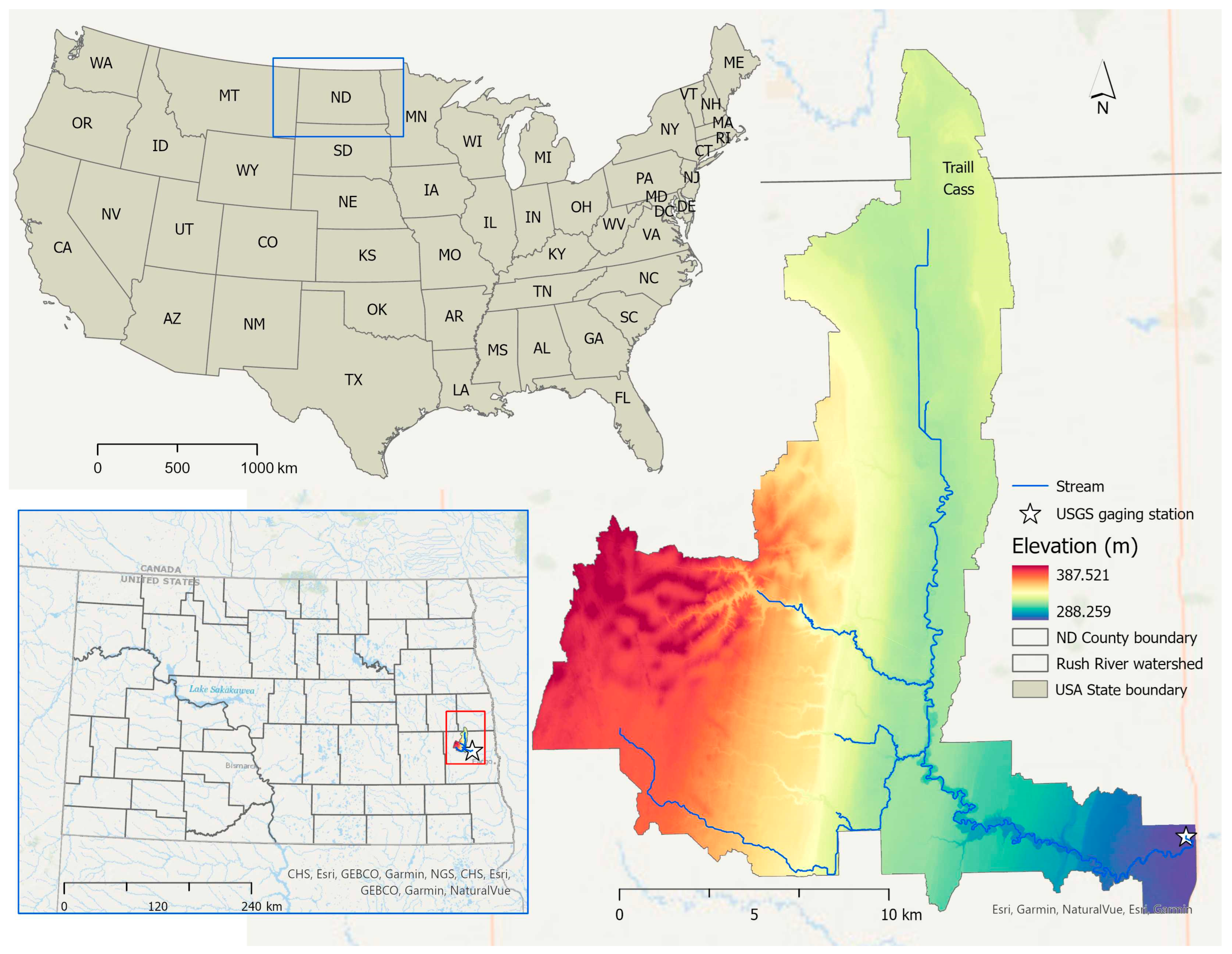

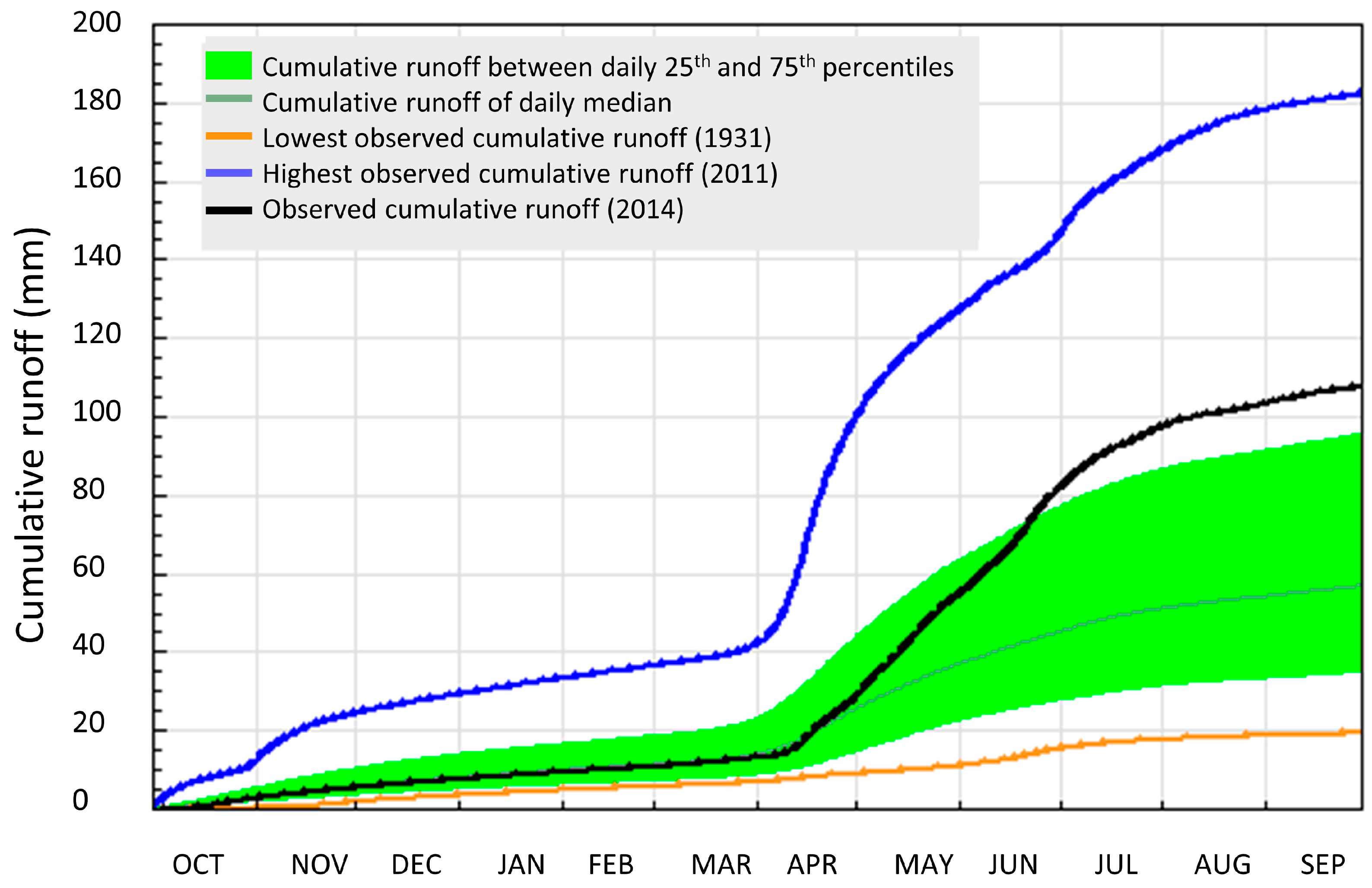
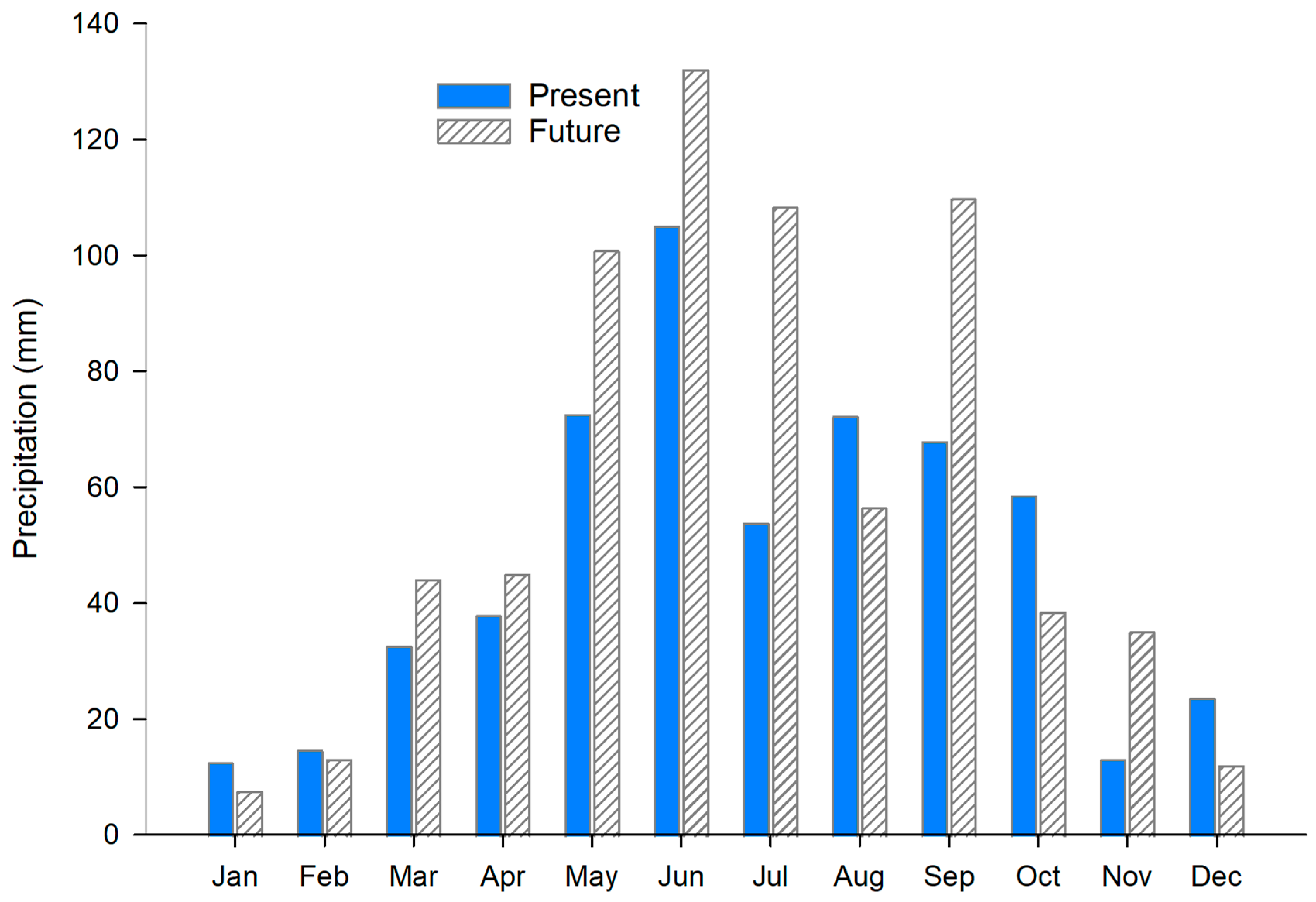
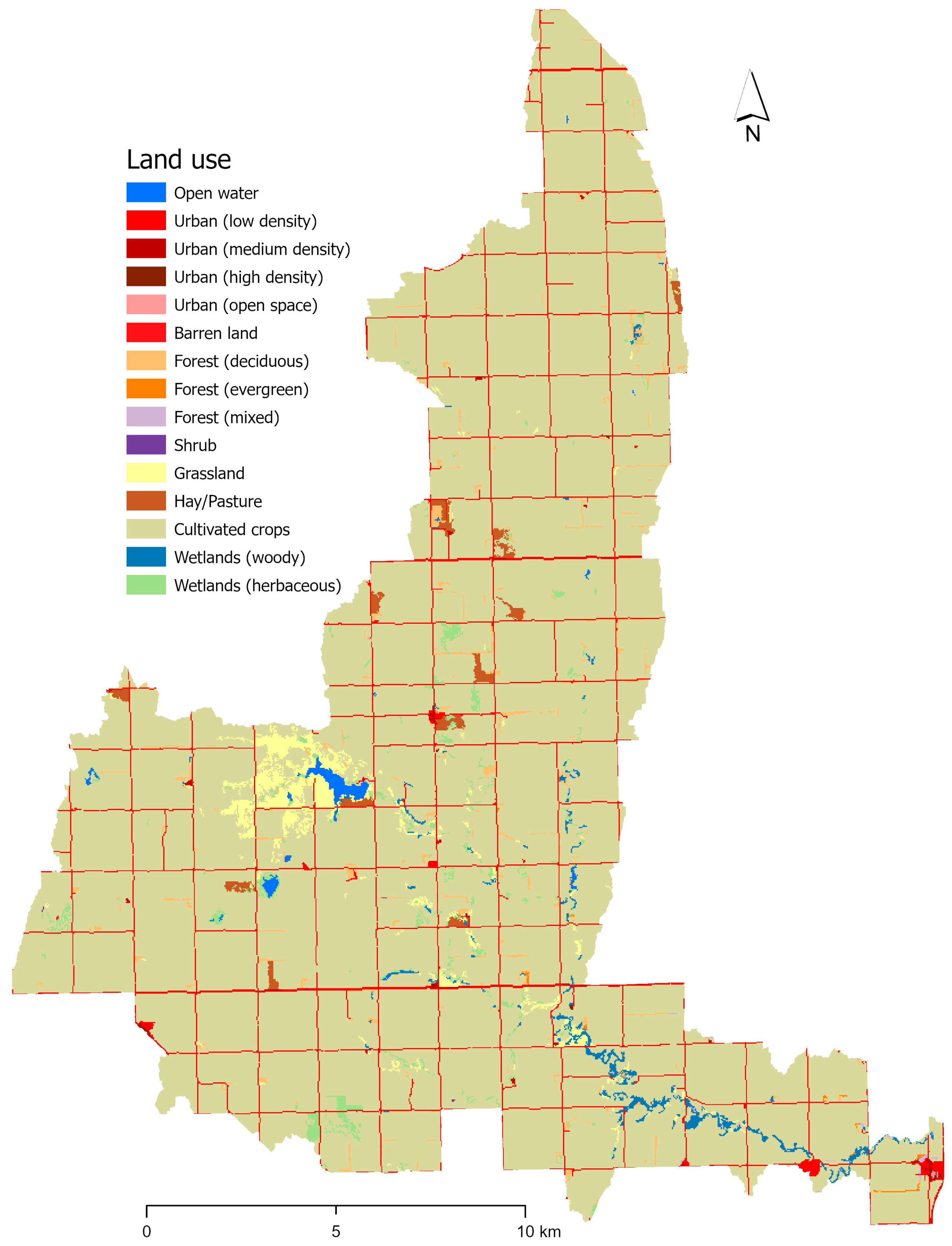


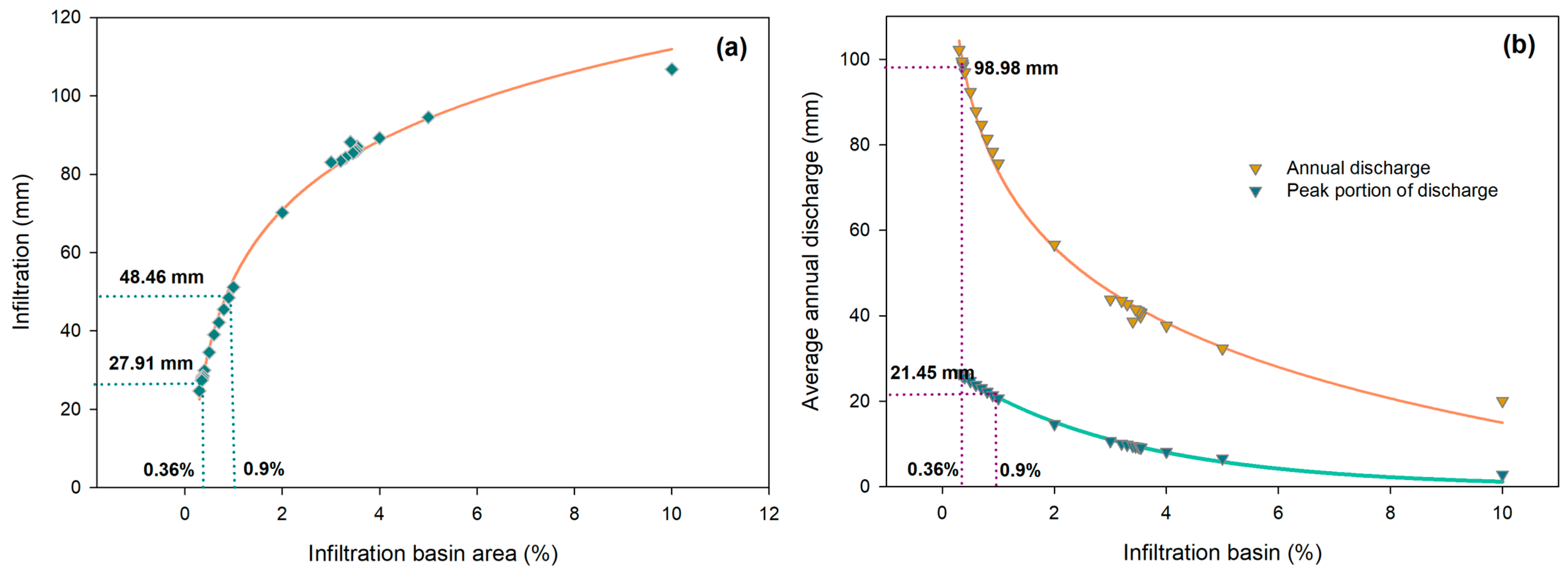
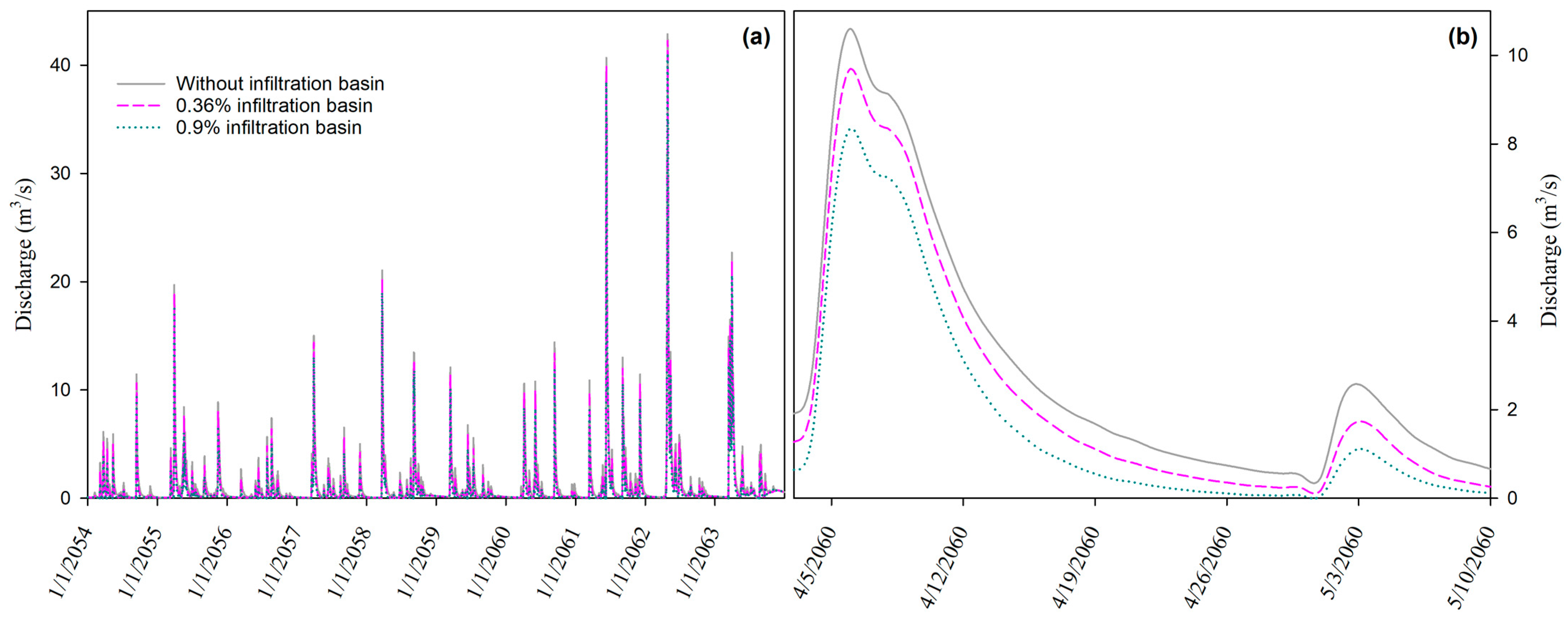
| Parameter | Description | Calibrated Values |
|---|---|---|
| * CN2.mgt | SCS curve number for moisture condition II | vary |
| GWQMN.gw | Threshold depth of water in the shallow aquifer required for return flow to occur (mm H2O) | 3336.553 |
| GW_REVAP.gw | Groundwater “revap” coefficient | 0.134851 |
| REVAPMN.gw | Threshold depth of water in the shallow aquifer for “revap” to occur (mm H2O) | 216.2931 |
| ESCO.hru | Soil evaporation compensation factor | 0.797276 |
| SMTMP.bsn | Snow melts base temperature (°C) | −1.03802 |
| SFTMP.bsn | Snowfall temperature | 4.557257 |
| SMFMX.bsn | Minimum melt rate for snow during the year (occurs on winter solstice) | 7.933271 |
| SMFMN.bsn | Maximum melt rate for snow during the year (occurs on the summer solstice) | 4.719988 |
| TIMP.bsn | Snowpack temperature lag factor | 0.171148 |
| CH_N2.rte | Manning’s roughness coefficient “n” value for the main channel | 0.031751 |
| CH_N1.sub | Manning’s “n” value for the tributary channels | 0.065375 |
Disclaimer/Publisher’s Note: The statements, opinions and data contained in all publications are solely those of the individual author(s) and contributor(s) and not of MDPI and/or the editor(s). MDPI and/or the editor(s) disclaim responsibility for any injury to people or property resulting from any ideas, methods, instructions or products referred to in the content. |
© 2024 by the authors. Licensee MDPI, Basel, Switzerland. This article is an open access article distributed under the terms and conditions of the Creative Commons Attribution (CC BY) license (https://creativecommons.org/licenses/by/4.0/).
Share and Cite
Han, Q.; Qi, T.; Khanaum, M.M. Evaluation of the Offsets of Artificial Recharge on the Extra Run-Off Induced by Urbanization and Extreme Storms Based on an Enhanced Semi-Distributed Hydrologic Model with an Infiltration Basin Module. Water 2024, 16, 1032. https://doi.org/10.3390/w16071032
Han Q, Qi T, Khanaum MM. Evaluation of the Offsets of Artificial Recharge on the Extra Run-Off Induced by Urbanization and Extreme Storms Based on an Enhanced Semi-Distributed Hydrologic Model with an Infiltration Basin Module. Water. 2024; 16(7):1032. https://doi.org/10.3390/w16071032
Chicago/Turabian StyleHan, Qiang, Tiansong Qi, and Mosammat Mustari Khanaum. 2024. "Evaluation of the Offsets of Artificial Recharge on the Extra Run-Off Induced by Urbanization and Extreme Storms Based on an Enhanced Semi-Distributed Hydrologic Model with an Infiltration Basin Module" Water 16, no. 7: 1032. https://doi.org/10.3390/w16071032
APA StyleHan, Q., Qi, T., & Khanaum, M. M. (2024). Evaluation of the Offsets of Artificial Recharge on the Extra Run-Off Induced by Urbanization and Extreme Storms Based on an Enhanced Semi-Distributed Hydrologic Model with an Infiltration Basin Module. Water, 16(7), 1032. https://doi.org/10.3390/w16071032







